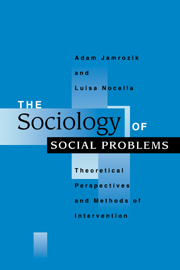Book contents
- Frontmatter
- Contents
- List of Tables
- List of Figures
- Preface and Acknowledgements
- 1 Introduction: Theoretical Perspectives on Social Problems
- 2 Contemporary Perspectives on Social Problems
- 3 Methods of Intervention in Social Problems
- 4 Social Actors in Social Problems
- 5 Challenges of Contemporary Social Problems
- 6 Social Problems in the Residualist Conversion Perspective
- 7 Inequality – The Underlying Universal Issue in Social Problems
- 8 The Social Construction of Family Problems
- 9 The Problem of Social Order
- 10 The Theory of Residualist Conversion: Does it Meet the Test?
- 11 Conclusions and Implications
- Bibliography
- Index
6 - Social Problems in the Residualist Conversion Perspective
Published online by Cambridge University Press: 29 March 2011
- Frontmatter
- Contents
- List of Tables
- List of Figures
- Preface and Acknowledgements
- 1 Introduction: Theoretical Perspectives on Social Problems
- 2 Contemporary Perspectives on Social Problems
- 3 Methods of Intervention in Social Problems
- 4 Social Actors in Social Problems
- 5 Challenges of Contemporary Social Problems
- 6 Social Problems in the Residualist Conversion Perspective
- 7 Inequality – The Underlying Universal Issue in Social Problems
- 8 The Social Construction of Family Problems
- 9 The Problem of Social Order
- 10 The Theory of Residualist Conversion: Does it Meet the Test?
- 11 Conclusions and Implications
- Bibliography
- Index
Summary
Social problems reflect society and its dominant values and interests. Expressing concern about certain conditions in a society is perceived as a threat to those values and interests – that is, to the power structure in society. To maintain the legitimacy of those values and interests, the power holders seek to remove social problems from the social sphere either by shifting them through explanation or deliberate action to places and forces beyond the control of the state, or by relating such problems through residualist conversion to the characteristics of the population strata experiencing them. Sometimes, a problem may remain in both the public and private spheres, its position being contested by parties with conflicting interests, according to their respective perceptions and interpretations. For example, unemployment has been explained by government policy, by unfair competition from other countries, or by the influence of some imported films or fashions being reflected in young people's ‘disruptive’ social behaviour and unwillingness to accept the discipline of formal and sustained employment obligations. Once a social problem is effectively located in a particular population group, it may further serve to maintain the legitimacy of those dominant values and interests by being used as an illustration of the penalty suffered by those who ‘fail’ to actively pursue the dominant values and corresponding goals.
In reflecting society (or perhaps showing a ‘flipside’ of its power structure), social problems indicate either the stability or the changing nature of society's dominant values, interests, and corresponding pursuit of certain goals.
- Type
- Chapter
- Information
- The Sociology of Social ProblemsTheoretical Perspectives and Methods of Intervention, pp. 103 - 127Publisher: Cambridge University PressPrint publication year: 1998

